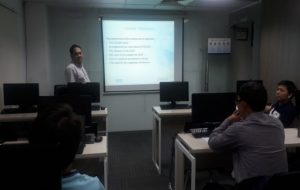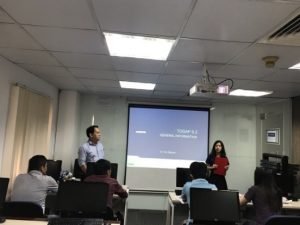 Course overview
Course overview
Students build knowledge on frameworks for building enterprise architectures for an organization. The course further helps students understand how to apply a design tool to describe the different models of business, data, application, and technology. At the same time, students learn how to build and manage an enterprise architecture development project.
Participants in piloting
The course is part of the graduate program in ICT at John von Neumann Institute. The course is also offered in the ICT graduate program at the Polytechnic University of Ho Chi Minh City. The following groups of students participated in the activities:
- 12 students enrolled in the semester 1 of academic year 2019 – 2020.
- 15 students enrolled in the semester 1 of the academic year 2020 – 2021.
The lecturer of the course is Dr. Huy Nguyen (JVN).
Timeframe
Fall 2020
Fall 2021
 Use of ALIEN services and tools
Use of ALIEN services and tools
Students were exposed to active learning through weekly lectures and tutorials. Practical activities took place in the ALIEN problem-based learning lab. The course was organized as a series of activities for building an enterprise architecture, including phases and deliverables. This work does not only require technical skills, such as modeling in business, data, application, and technology, but also business skills to define, collect, and analyze information on developing an enterprise architecture project. Diverse learning activities and teaching methodologies were used to best address the objectives of each learning session.
Students implemented the following steps:
- Students studied, presented, and discussed the general definition of enterprise architecture.
- Students selected a business scenario to build an enterprise architecture work.
- Students looked for different business reference models to use in their scenario.
- Students reviewed lessons with interactive games using Kahoot®. Students created the games themselves under teacher guidance. After each game, the lecturer posed questions on the wrong or unclear answers, encouraging students to discover more on the missed points.
- Students played scenario games in which they provided input related to the practical application of knowledge and techniques in developing enterprise architectures.
- Students used EA Sparx® and Dropbox® to build and share their results with their classmates and lecturer.
In the context of tutorials, students further implemented the following activities:
- Students worked in groups to develop models and presented their results to their peers and the instructor.
- Students summarized their results in a shared document that they collectively edited.
- Students raised concerns or interests during the course and engaged in discussions with their classmates in the final session. The lecturer helped students align their points with the framework of the course for developing more effective understanding of concepts and enabling student to apply new knowledge in practice.


